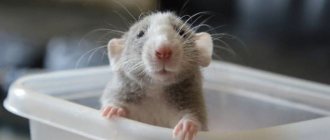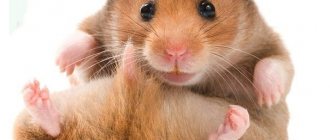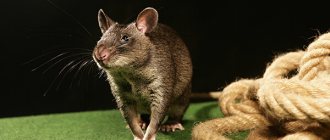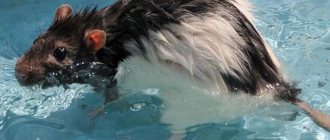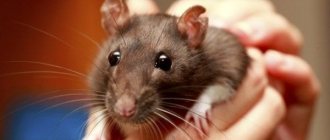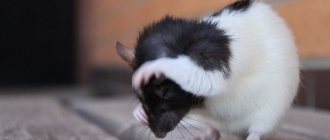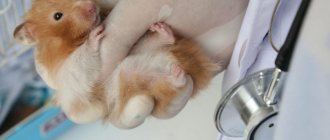Any animal that a person gets at home requires adequate care and maintenance. Without the right attitude towards your pet, he will definitely get sick. Therefore, you need to ask yourself the question: are you ready to take responsibility for the animal? Before buying a specific animal, you need to at least minimally study the rules of its maintenance, nutrition and possible diseases.
One of the most common pets is the decorative rat. She is not as aggressive as her street counterparts and does not tolerate infections (unless, of course, she was initially sick). Most rodents are affectionate and respond well to human interaction. However, no owner is insured against possible pet diseases. Therefore, you need to know what diseases rats suffer from, how to treat them, and what preventive measures to take to protect the animal.
Reasons why a rat may be choking or panting?
Attention! Due to the rapid metabolism of the decorative rat, diseases progress very quickly. It is impossible to identify them, much less cure them at home. Therefore, in case of any deviations in the breathing process, you must contact a veterinarian or, even better, a ratologist.
If extraneous sounds are heard during breathing (wheezing, whistling, etc.), it becomes confused or the animal is suffocating, this may be the cause of various diseases.
Respiratory diseases (bronchitis, pneumonia, asthma)
A rat's heavy breathing is a bad sign.
Sometimes even a common cold can cause more serious illnesses, resulting in death. For respiratory diseases, the following symptoms are distinguished:
— the rat constantly grunts and sneezes;
— dried brownish mucus appears on the nose and eyes, it is called porphyrin;
- a characteristic whistle is heard, the animal breathes frequently and unnaturally from its sides;
- there is a cough of varying intensity and humidity, wheezing and gurgling are heard when breathing, the rat opens its mouth;
- in neglected situations, the rat characteristically hunches its back, moves little and often sleeps;
- in severe cases of the disease, the rodent refuses to eat, apathy, ruffled fur, and mucous discharge from the eyes and nose are observed.
Have you noticed similar signs in your rodent?
Cardiovascular diseases (heart failure, heart attack, stroke)
Heart failure can occur in any rat, regardless of age. This disease also causes striking symptoms:
Is the rat grunting? Let's run to the vet!
— the animal gains weight sharply, a huge belly appears;
- sometimes the opposite situation occurs: the rodent quickly loses weight, the fur becomes dull and disheveled;
— the domestic rat loses activity, becomes easily fatigued, and the animal sleeps a lot;
— breathing becomes wet and heavy, the rodent grunts, wheezes and coughs;
- the tips of the animal’s tail and fingers become cold and blue, the hind legs are weakened.
Older, older rats may have a heart attack or stroke.
These diseases are characterized by the following symptoms:
- the animal falls on its side and convulses;
— the rodent opens its mouth and gasps;
- limbs move involuntarily.
Note: Cardiovascular and respiratory diseases may present with similar symptoms, but the treatment required is completely different. Therefore, it is impossible to diagnose and treat an animal on your own, without the help of a specialist.
If a rat is breathing heavily, this is not normal!
Key points in emergency care
If a rat has problems breathing, it must be taken to a veterinarian. He will carry out the following procedures:
- Provide humidified oxygen if necessary.
- Give your pet saline or antibiotics.
- Prescribe parenteral antibiotics such as oxytetracilline (60 mg/kg intramuscularly every 72 hours) or long-acting doxycycline.
- Feed the pet. The owner can help feed the rat using a syringe.
The veterinarian will also ask you about the clinical disease, as well as all the details associated with caring for the rat (housing, diet, cage mates). This is necessary for an accurate diagnosis.
How to help a rat if it is panting, choking or grunting
Common causes of shortness of breath and breathing problems in rats are pneumonia and heart attack.
The most important thing to do is contact a veterinarian. Only a specialist can prescribe adequate treatment. If wheezing or other breathing problems occur, you can provide your pet with first aid and additional measures to the main treatment.
In case of a heart attack, when the animal is breathing heavily and making wheezing sounds, you must definitely pay attention to the tail and ears (they turn pale); fingers and tail tip (turns blue). Convulsions begin, the animal moves its limbs chaotically.
To provide first aid to the animal, you need to drop a few drops of Corvalol into the rodent’s mouth and rush to the veterinarian as soon as possible. Try to handle your pet as little as possible during an attack. In this state, he is capable of injuring your hand with a bite. Because of this, the animal may fall, which will further aggravate the situation. You should remove all unnecessary and traumatic objects (tunnels, ladders) from the cage. During an attack, the rat does not control itself and can injure itself.
Reference : pneumonia in rats is an infection that affects the animal’s lungs. Inflammatory processes occur in the rodent's respiratory organs.
If your rat is sneezing more than usual, listen carefully to the animal's breathing. In the case when the breathing is even, there are no mucous discharges from the nose, you just need to observe the behavior of the animal. You should not start treatment until you are sure that the animal is actually sick. The cause of sneezing may be a simple allergy or dust.
If the animal makes unnatural, grunting sounds, your rat is sick! Contact your veterinarian immediately!
Grunting sounds in the sinuses indicate that they are full and breathing is difficult . The disease progresses very quickly, so it is worth taking steps to consult a veterinarian. Based on the diagnosis, he will prescribe a course of antibiotics.
Important! You can become resistant to an antibiotic. Because of this, you will have to start all over again, but with a different, stronger medicine that can cause even more harm to the animal. Therefore, a clear diagnosis by a specialist is needed.
Ratologist will help save the rat
Measures to restore animal health
In order to cure your pet as quickly as possible, in addition to a course of antibiotics, it is necessary to take measures to restore the animal.
— The rodent’s cage must be reliably protected from drafts. — The room in which the cage is located should have normal air humidity . It should not be overdried.
— The cage should be thoroughly cleaned daily: the ammonia smell irritates the animal’s nose and breath.
— A heating pad installed in the cage also promotes recovery.
— Echinacea decoction will help strengthen the rat's immune system.
— If the pet is not alone, you need to seat the animals in different cages to prevent the spread of infection.
Forecast
Rat respiratory mycoplasmosis is usually a chronic disease, but early treatment reduces the severity and duration of the disease.
Antimicrobial therapy may not completely eliminate the infectious agent, so treatment is often necessary to repeat. Infected rats usually remain a potential source of disease transmission to other rats throughout their lives.
Drug treatment of tracheitis
The drug treatment regimen for acute tracheitis is drawn up taking into account the nature of the disease and the severity of the patient’s symptoms.
Impact on the cause
If the causative agent is a particular virus, antiviral agents are usually used, as well as immunostimulants (for example, preparations based on echinacea). For severe and protracted tracheitis of a bacterial nature, the doctor may introduce antibiotics into the treatment regimen. If the disease proceeds without complications, it is usually possible to cope with it without these remedies. But the decision on the rationality and duration of antibiotic therapy should be made only by a doctor. In some cases, with tracheitis, a bacteriological examination of sputum is carried out before starting treatment with antimicrobial agents. It is sown on nutrient media to determine the type of pathogen and its sensitivity to the main groups of drugs. This will help you choose the most suitable antibiotic.
Treating coughs and clearing the airways
When treating acute tracheitis, great attention should be paid, of course, to cough, the main symptom of the disease. For a dry, debilitating, nonproductive cough, medications that suppress the cough reflex are used. This measure may be necessary in the first days of tracheitis. At the next stage of the disease, the main goal of treatment is to clear the airways of the mucus that forms. To do this, it is necessary to facilitate its passage with the help of mucolytic and expectorant agents. But they cannot be used simultaneously with antitussive drugs. It is also unacceptable to suppress a wet cough. This is fraught with stagnation of sputum and the transition of inflammation to the underlying parts of the respiratory system, up to the development of bronchopneumonia.
Maintenance therapy
Herbal remedies may be helpful to relieve the symptoms of tracheitis. For tracheitis, they can be used in the form of decoctions and infusions. But a more convenient and reliable method of treatment is the use of ready-made herbal products with a carefully selected and balanced composition. For example, in a complex treatment regimen for tracheitis, you can include Doctor MOM® cough syrup, which contains extracts of licorice, elecampane, Vasiki adatodes, Indian nightshade and other medicinal plants - 10 medicinal plants in total. It is suitable for both adults and children over 3 years old. This remedy helps thin mucus and helps remove it from the respiratory tract, and also relieves inflammation. For adults, there are also herbal cough lozenges Doctor MOM® based on extracts of licorice, ginger and Emblica officinalis. They also soften coughs and have anti-inflammatory and expectorant effects. Such lozenges can be used as an aid in the treatment of tracheitis. They help cope with coughing attacks and ease the course of the disease.
Why does acute tracheitis occur?
Infection
The development of the disease is most often caused by viral infections - influenza and other viruses that affect the respiratory tract and respiratory system. Bacteria can also be causative agents: pneumo-, strepto-, staphylococci and others. Often there is a so-called mixed infection, when inflammation is caused by several different pathogens at once. In this case, most often the bacterial infection is secondary; it complicates the course of ARVI.
Non-infectious factors
Acute tracheitis in an adult can also be non-infectious in nature, although this is less common.
- Mechanical injuries
. Traumatic tracheitis is possible when foreign bodies enter the respiratory tract, for example, as a result of insufficiently careful endoscopic examination of the bronchial system and tracheal intubation during surgical anesthesia.
- Thermal effects - inhalation of cold or (less often) very dry hot air
. In this case, the key point in the development of inflammation is not irritation of the walls of the trachea, but the vascular spasm that occurs in them. This leads to disruption of the functioning of the glands in the walls of the trachea and a decrease in the protective function of its mucous membrane.
- Chemical burns that occur when inhaling fumes from alkaline or acidic products
. These can be aggressive household chemicals, industrial waste, paint and varnish products, petroleum products, chemical reagents. This type of tracheitis is especially difficult.
- Irritation of the mucous membrane of the respiratory tract by polluted, dusty or excessively dry air
. Tobacco smoke, including passive smoking, is of particular importance.
- An allergic reaction in response to the entry of individually significant allergens into the respiratory tract
. In this case, tracheitis is usually combined with laryngitis, obstructive bronchitis (complete obstruction of the bronchial tubes) or even pulmonary edema.
Sometimes tracheitis becomes an occupational disease, that is, its occurrence is associated with harmful factors at work. Therefore, workers in hot shops, farms, chemical and oil refineries, as well as miners and stonemasons are at risk.
What diseases do rats and mice carry?
Decorative pets can “share” infectious pathologies. The list of potentially dangerous to humans includes:
- plague, typhus;
- "rat bite" (sodoku);
- pneumonia;
- toxoplasmosis, listeriosis;
- tularemia, leptospirosis;
- rickettsiosis, toxocariasis;
- rabies, hemorrhagic fever.
The list of diseases from rats and mice will continue with fungal diseases (ringworm), pasteurellosis, and lymphocytic choriomeningitis. Diseases are transmitted by airborne droplets, through skin lesions and bites. Domestic rodents are less dangerous, but you should still not have close contact with them, kiss them, or eat from the same plate.
